-
Viewpoint on 'IONS'
Viewpoint on 'Scientific Literacy'
- Proudly sponsored by
-


-
Peeking Around Corners
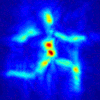
Until now cameras have only been able to see what is in front of them. Thanks to recent developments in ultra-fast imaging and computational photography, they may also soon be able to see objects out of the line of sight.
-
Sailing through the Waves of Light
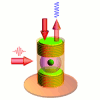
The difference in the interaction between an atom and light can be as wide as that between a pleasant, relaxing canoe ride, and a whitewater rafting experience. It is now possible to switch back and forth between the two, ultraquickly, at the touch of a laser pulse.
-
Forensic Optics: Transforming a Hair into a Travel Log

Solving crimes requires and complicated investigations in order to find clear evidence. Now, it is possible to obtain information about a suspect's travel history by analyzing their hair.
Journey to the Center
of the Earth
What happens when we put an electric insulator, such as iron oxide, under pressure and temperature conditions as extreme as those of the Earth’s interior? The insulator turns into a conductor: a notion that will help us to refine our current understanding of the Earth’s magnetism.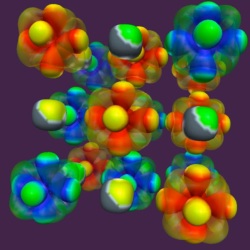
Metal or Insulator? The image shows the charge density in the rock-salt structure of FeO. At room temperature and pressure this mineral is electrically insulating, but at the temperature and pressure conditions of Earth’s lower mantle it behaves like a metal. Image courtesy: Robert E. Cohen.
We can think of our planet as a layered onion, where things get more extreme, in terms of temperature and pressure, as we move towards its core: the solid surface, or crust, which we live on is followed by a rocky upper mantle; beneath that, composed of plastic flowing rocks, lies the lower mantle; then, finally, the liquid outer core and the solid inner core with temperatures reaching more than 5000 degrees Celsius. This is the structure we have been able to deduce based on theoretical assumptions, or indirect experimental observations. Of course, if we were characters from Verne’s Journey to the Center of the Earth, we would be able to travel inside our planet and assess this model directly. Unfortunately, the reality is rather more complex and even though we cannot simply stroll down to the core of our Planet, new pieces of evidence are constantly added to the puzzle.
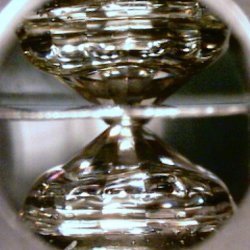
A hot compression. A magnified image of the anvil diamond cell used by the researchers to recreate temperature and pressure conditions comparable to those in the lower mantle of the Earth. In the picture, a very thin foil of iron oxide is compressed between the tips of two diamonds. Picture courtesy: Andrew Campbell.
The new result seems to indeed suggest the existence of such a metallic layer: iron oxide (FeO), an important mineral in the Earth’s lower mantle, converts from an insulator to a metal at high pressures and temperatures, similar to those found in the interior of the Earth. "FeO is a very important mineral in the Earth," Fischer points out. "The second most abundant mineral in the Earth’s lower mantle is ferropericlase, which is a solution of MgO and FeO. Additionally, while the Earth's core is mostly comprised of iron, we know that it also contains several weight percent of one or more lighter elements, and oxygen is a leading candidate. So FeO might also be a component of the Earth's core, especially the outer core. Understanding the properties of FeO can therefore help us interpret seismological, geodynamic, geomagnetic, and other types of data we have on the Earth's deep interior."
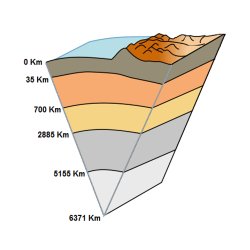
A layered onion. Our planet can be divided into five layers: crust, upper mantle, lower mantle, outer core, and inner core; things get more extreme, in terms of temperature and pressure, as we move towards its core. Adapted from Wikipedia/Surachit.
What is clear, as Cohen suggests, is that these findings may lay the foundations for a better understanding of the Earth’s magnetism, and offer new insight into its many poorly understood aspects. "The deep interior of the Earth and planets are real mysteries," Sabine Stanley at the University of Toronto (Canada) comments. "They have extreme conditions that are hard to simulate in the lab and on computers, but researchers are getting better and better at this. As we learn more about Earth's deep interior, we will be able to better understand Earth's structure and evolution in time." And Cohen concludes: "We used to think that the Earth was a metallic core surrounded by an insulating layer. Now, we see first evidence that this is not the case, and this will influence the way we think about the Earth’s magnetism and its impact on life itself."
[1] Ronald E. Cohen worked on the theoretical side of the research, while the experiment was performed by Kenji Ohta at Osaka University in Japan.
Giorgio Volpe
2012 © Optics & Photonics Focus
GV is currently working on his doctoral thesis at ICFO - The Institute of Photonic Sciences, Barcelona (Spain).

Kenji Ohta, R. E. Cohen, Kei Hirose, Kristjan Haule, Katsuya Shimizu & Yasuo Ohishi, Experimental and Theoretical Evidence for Pressure-Induced Metallization in FeO with Rocksalt-Type Structure, Physical Review Letters (2012) 108, 026403 (link).
Rebecca A. Fischer, Andrew J. Campbell, Oliver T. Lord, Gregory A. Shofner, Przemyslaw Dera & Vitali B. Prakapenka, Phase transition and metallization of FeO at high pressures and temperatures, Geophysical Research Letters (2011) 38, L24301 (link).